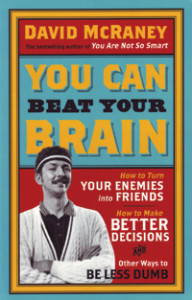You Can Beat Your Brain
How to make better decisions and be less dumb
by David McRaney.
Published by Oneworld www.oneworld-publications.com
Before we go any further, I’d like you to take a quick look in a mirror. What did you see? A rational, insightful person with a keen awareness and nuanced understanding of people and the world around you I’ll bet. Probably more perceptive than most if you’re being honest eh? Wellll… As it turns out, not so much. Over the last few decades psychology and neuroscience have discovered that most of the time what we’re mostly good at is fooling ourselves.
Our minds are a bit like our smartphones – full of apps to help us get through our day. Most of our brain apps though were evolved when our ancestors were tree shrews and the rest when they were barely more than planes apes starting to walk upright. Mostly they are tricks to make a complex, fuzzy world seem clear and simple so you can make quick decisions and stay out of predator’s mouths’ long enough to reproduce. Unfortunately there haven’t been any updates in the last 100,000 years and certainly nothing to help us cope with fast cars or facebook friendships.
“Know Thyself” said Plato and David McRaney wants to help us with that. In “You Can Beat Your Brain” he’s assembled 17 of our brain’s blind spots to show us where our obsolete survival apps let us down in the modern world. If you know you have a bad memory you can leave Postits by the phone. If you know how your rationality goes astray you can – hopefully – factor that in when you need to make decisions and stop, as McRaney so eloquently puts it, from falling into a big hole of stupid.
For example there’s the Self-Enhancement bias that keeps you upbeat in a world that mostly wants to eat you. The Sunk Cost Fallacy tells you why you throw good money after bad. Deindividuation explains why crowds shout ‘jump’ at people on ledges (some days it’s had to be a humanist – if you ever find yourself in this situation can you do me a favor and try to get a chant of ‘go back’ going? Thanks). The Misattribution of Arousal is why rollercoasters are a good first date. The Backfire Effect demonstrates you can never win an argument on the Internet and Asymmetric Insight shows that you don’t know your friends or opponents as well as you think you do. It’s not all bad news though, the Benjamin Franklin Effect shows you how to use other people’s faulty brain apps to make friends out of enemies.
Most of these cogitative biases have been covered elsewhere in greater depth. Readers of Daniel Kahneman’s “Thinking Fast and Slow” will recognize some elements including the (flawed) example of Linda the feminist bank teller in the chapter on Common Belief Fallacy for example. Rarely though have so many of the mind’s mistakes, short-cuts and prejudices been brought together in so readable a format. While underlining interesting bits in the introduction (yes, I write in books, try and move past it) I realised I was underlining almost every second sentence. You shouldn’t take this to indicate that I am a profligate underliner but rather that even the introduction is chock full of interesting insights. If you don’t have time for the whole 274 pages you can try this bit out on Amazon for free. Be warned though – once you do, you will be clicking ‘purchase’.
The one problem with ‘You Can Beat Your Brain” is that it is itself one of the oversimplifications it warns us about. These are not scientific papers. There are no error bars. The chapters are popularised accounts of what are, in many cases, already popularised descriptions where irregularities and uncertainties have been smoothed over for brevity and impact. Bare in mind that things are usually more complicated than they seem even when you’ve allowed for the fact they’re more complicated than they seem and just maybe we can beat our brains.
